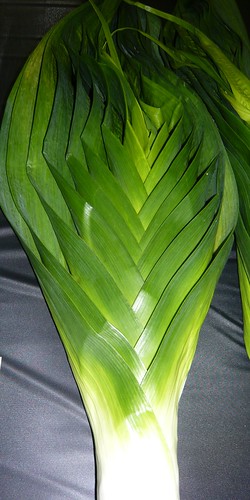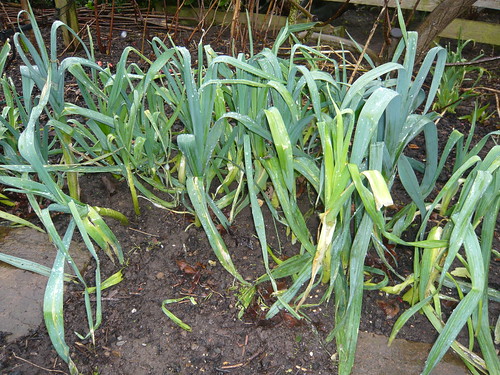Leeks and Pot Leeks
Starter Tips
- Grow culinary leeks in ground with well rotted compost that hasn’t cropped leeks for the past 3 years.
- Sow autumn and winter varieties in deep pots during late March or April
- Transplant in June-July so about two thirds of the plant is buried increasing the length of blanching.
- For average sized leeks plant 6 inches apart in rows a foot apart.
- Nitrogen fertiliser in autumn helps winter growth
- Grow Pot Leeks for competitions prevalent in the North East of England.
Leekology
I first went to a Leek show in the North East one September about 40 years ago and the Pot Leeks on show were really something to behold.
It is an art, a science and a bit of black magic that helps create a show stopper in this region renown for its prize leeks.
Pot leek exhibition standards require a blanch of up to 6inch which can give a circumference of 28″. Intermediates are up to 14″ blanched length and Long leeks are anything in excess of this. For eating purposes, size is much less important than flavour. We will concentrate on normal garden culture for flavour.
Tips on starting to grow Leeks
- Seeds can be sown in Mid march until June as the plants like a long growing season.
- Set out the plants at the end of May.
- A quick and easy start can be made by buying seedlings from a nursery or market stall.
- Using seeds and seedlings from various sources can give you different varieties that mature at different times
- Soil should be trenched and not too heavy or excessively manured. Soil manured for a previous crop is fine perhaps with extra grit (or ash as used in the North East) if the soil is heavy.
- Starting from pods or pips, the advantage is that the offspring will have the same characteristics as the parent and, if this were a prize-winner, the offspring would also be potential prize-winners. Pods are the delicate swellings or leaves like grass which form on the head of the plant after flowering. Since we are growing to eat we won’t be letting them flower so this method of propagation will not be used.
Tips on Easy Planting Out
- Make a hole with a dibber and drop a plant into the hole. Encourage soil to part fill the hole by watering. The easiest way to form a tender white stem (blanching) is to transplant the young leek plants so that the base of the leek is at least 9ins/20cms below the surface of the soil
- Shorten the brittle roots and the leaves if they are straggly before planting
- Leeks love moisture – keep them well supplied with water
- If planted in a trench then soil can gradually be pulled in around the stem to encourage blanching (the whitening of the stem).
- Alternative blanching can involve a paper collar or wrapper held on with a rubber band but I am happy with shorter tender leeks and don’t bother.
- Leeks are a hungry crop. Feed with a weak solution of a nitrogen based fertiliser and as the leek grows move to a balanced fertiliser.
Harvest as required many varieties can stand in the ground through early winter. Returning to pot leeks for show, some do get planted in the Autumn but.you wont find that recommended in seed catalogues!
Big seeds don’t guarantee big plants but it is a start. http://www.mammothonion.co.uk/index.htm
Recommended Varieties
- Musselburgh- hardy with long thick stems
- Jolant- is a variety I am trying this year for the first time “ it has RHS award of merit
- ‘The Lyon’ – autumn variety with mild-tasting long stems an old favourite
- ‘Monstruoso de Carentan’ – French heritage leek with short stems from October to January large thick stems with blue green foliage
- ‘Pandora’ – glaucous leaves and long white stems. Crops between September and January
- ‘Autumn Giant 2 Porvite’ – tasty, white stems
- Giant Winter (AGM) excellent late variety with fine, long, white stems which will stand in the ground for a longtime
Further Leek Tip Round Up
- One of my favourite crops to grow the Leek take little effort and stands up well through even tough winters.
- Fortunately they haven’t run to seed. If they don’t get picked and eaten soon the flower head will shoot up from the middle of the leek and the stem becomes hard and tough.
- After flowering the leek’s seedhead can develop ‘Grass’ like miniature bulbils that are prized by growers particularly if the grass comes from a good specimen to form the start of the next crop.
- I try to avoid growing Leeks in the same ground year after year but as they like a good rich soil it is tempting.
- It is a first for me this year as many Leeks have been nibbled away by starving Rabbits. When I was injuncted to ‘eat up your leek’s it wasn’t an invite for a free for all.
- A search on Thompson & Morgan will bring up over 40 varieties of Leeks seeds and products that can be bought and planted in February- May
Leek Varieties Recommended by Thompson & Morgan
Allium porum Bandit F1
An outstanding variety for harvesting from winter through to spring. Leek Bandit has excellent garden performance and winter hardiness, showing good tolerance against rust and bolting. Good weight of stem without bulbing and dark leaves. The dark leaves of Leek Bandit contrast with pure white, thick stems of superb flavour.
Allium porum King Richard
A very early variety. Leek King Richard produces extra long, slim stems which don’t need earthing up and are ideal for slicing. From earliest sowings it is ready in June-July, and later sowings, August-September, stay ready for use until Christmas. You can also direct sow Leek King Richard without the need to transplant, or grow closer together for delicious, succulent mini leeks.
Allium porrum F1
An outstanding cultivar for harvesting from winter through to spring. The dark leaves of Leek Bandit contrast beautifully with delicious, thick, pure white stems. This variety has excellent garden performance and winter hardiness, showing good tolerance against rust and bolting. Height: 45cm (18. Spread: 20cm T&M’s easy starter plants are expertly grown, taking away all of the worry of raising your own. Delivered ready for planting so that you can enjoy bigger, earlier and tastier vegetables. Our quality vegetable plants will be dispatched at the correct time for planting. Please note: Delivery is subject to plant size, adverse growing conditions during production may delay dispatch schedules.
Leek Problems incl Virus, Fungus and Bacteria
- Leek Rust
- White Tip related to potato blight
- Botrytis – grey mould
- Pink rot or ‘soil marks’ White rot Black rot all fungi
Leek Pests
- Aphids particularly on young plants and in greenhouses
- Soil pests
- Slugs
- Leek Moth:-
- Will not affect ornamental alliums
- White or brown patches develop where leaves have been eaten by caterpillars.
- Larvae bore into bulbs or stems causing secondary rots.
- More prevalent near the coast where two generations in May and October can cause problems
- No effective insecticide for home gardeners
- Keep plants well watered in summer for strong growth
- In severe cases grow under fleece
Onion White Rot
- Affects onions garlic shallots but less severe on leeks.
- Symptoms include yellow and wilting leaves
- Roots rot and leave mould and black sclerotia in the soil which can survive to cause problems for 8 years
- Plants become loose in the soil and start to go soft.
- Most severe in cool wet summers
- Transmitted by contaminated soil not airborne
- Control by destroying affected plants before sclerotia form. There is no chemical control.
- Avoid spreading contaminated soil on boots.
Bibliography
- _leeks-growing-guide-smgr0x45
- Canny Leek Growing D A Calderbank
- Onions, Leeks, and Garlic – A Handbook for Gardeners By Marian Coonse
- The Leek Book. A Comprehensive Guide to the Practical Growing and Showing of Exhibition Leeks. G. F Swaddle


2 thoughts on “Leeks and Pot Leeks”
Comments are closed.